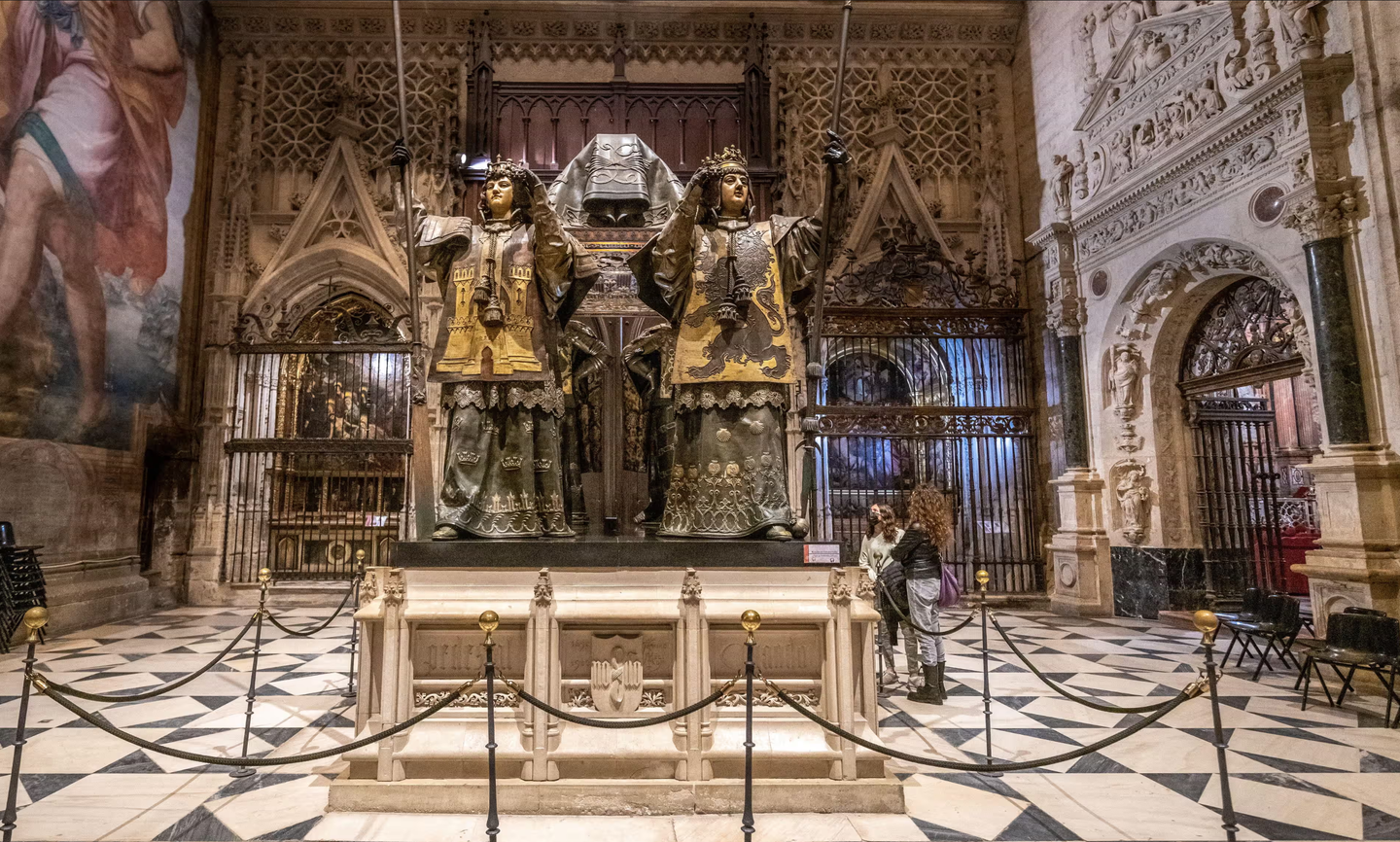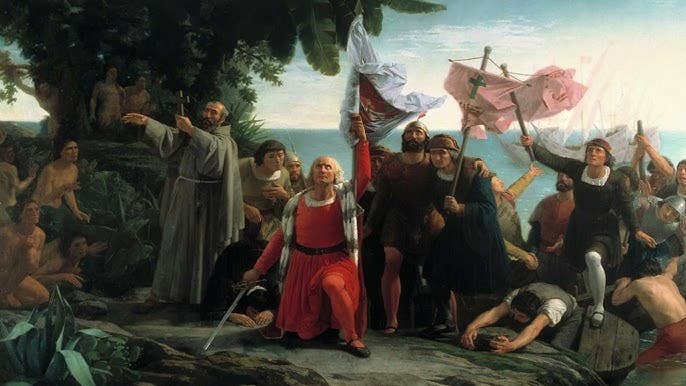Final resting place of Christopher Columbus identified
Columbus’ transformative impact on the Americas is undisputed, yet questions about his final resting place have persisted for generations

Columbus’s remains were brought to Seville in 1898 and buried in a tomb in the city’s cathedral. (CREDIT: CC BY-SA 4.0)
Centuries after his death, Christopher Columbus remains a subject of intrigue and debate worldwide. His historic 1492 voyages across the Atlantic are widely recognized, but his legacy is fraught with controversy, both during his life and long after.
Columbus’ transformative impact on the Americas is undisputed, yet questions about his origins and the final location of his remains have persisted for generations. Now, a team of Spanish researchers claims to have solved these enduring mysteries, drawing on decades of meticulous DNA analysis.
Columbus, often credited with ushering in European colonization of the Americas, has a life story cloaked in uncertainty. While he is generally accepted as being of Genoese origin, some scholars have long questioned this narrative, suggesting he might have had Portuguese, Basque, or even Jewish ancestry. Equally perplexing has been the journey of his remains, which have been moved several times since his death.
The explorer died in Valladolid, Spain, in 1506 after a lifetime marked by navigation triumphs and contentious leadership. Although his death was relatively uneventful, the saga of his remains has been anything but straightforward.
Initially buried in Spain, they were later moved to Santo Domingo, then to Cuba, and back to Seville, Spain, where they now rest in a grand cathedral. Along the way, a second set of bones, believed to be his, was discovered in the Dominican Republic, further complicating the story.
José Antonio Lorente, a forensic researcher from the University of Granada, has led efforts to confirm once and for all whether the remains in Seville’s Cathedral truly belong to Columbus. His team used DNA samples from the explorer’s brother Diego and son Fernando to compare with the remains in Seville.
"Today, thanks to new technology, the previous partial theory that the remains in Seville are those of Christopher Columbus has been definitively confirmed," Lorente told The Guardian.
Though the Seville remains are indeed Columbus’, the issue of whether parts of his body remain in the Dominican Republic has yet to be fully settled. A lead box found in 1877 in Santo Domingo’s Cathedral contained bone fragments labeled “Illustrious and distinguished male, Christopher Columbus.” Lorente suggests both sets of remains could, in fact, be Columbus, as both are incomplete.
Related Stories
The findings of a recent study were announced in a documentary titled Columbus DNA: The True Origin, which aired on Spain's national broadcaster, TVE.
As for Columbus's ethnicity, "We have DNA from Christopher Columbus, very partial, but sufficient. We have DNA from Hernando Colón, his son," explained Lorente in the program. "And both in the Y chromosome (male) and the mitochondrial DNA (passed through the mother) of Hernando, there are traits compatible with Jewish origin."
Before Catholic monarchs Isabella and Ferdinand ordered Jews and Muslims to either convert to Catholicism or leave Spain, about 300,000 Jews lived in the country. Many of them later resettled across the world, and the word Sephardic originates from "Sefarad," the Hebrew term for Spain.
Lorente noted that after evaluating 25 possible locations, they could only confirm that Columbus was born in Western Europe.
These discoveries come after two decades of painstaking research. Yet, despite the scientific rigor behind the DNA studies, the findings have been packaged into a television special. While such commercialization might detract from the gravity of the discoveries for some, the research itself represents an important milestone in solving the enigma of Columbus.
As Spain celebrates its national holiday, marking Columbus’ arrival in the Americas, the country will also be tuning in to a program that promises to finally reveal the explorer’s true origins. Theories about his background have abounded for years. Was he really Italian, or could he have hailed from another European country?
The program’s creators insist they’ve found the answer, and they claim that, out of 25 possible origins, eight finalists were considered before concluding the true birthplace of the famed explorer.
Lorente, however, remains cautious. While he has suggested in the past that Columbus was indeed Genoese, he has held back on definitive statements, noting that the research could lead to findings valuable for historical analysis. “There are some really important results – results that will help us in multiple studies and analyses that should be evaluated by historians,” he remarked in a press conference.
Columbus’ legacy, much like his remains, has been scattered and debated. While many in the U.S. grew up hearing the phrase “Columbus discovered America,” this narrative has become increasingly controversial. Columbus never set foot on the mainland of what is now the United States. His expeditions primarily brought him to the Caribbean and Central and South America.
Furthermore, the impact of his voyages on the indigenous peoples of the Americas was catastrophic, leading to centuries of colonization, exploitation, and genocide.
In recent years, his legacy has been reexamined, with public figures, particularly in Spain and the U.S., denouncing the celebratory tone that often surrounds Columbus. In 2015, Ada Colau, the then-mayor of Barcelona, openly criticized Spain’s national day, stating, “Shame that a nation celebrates a genocide and, on top of that, with a military parade that costs 800,000 euros.”
Her sentiments were echoed by José María González Santos, the mayor of Cádiz, who said, “We never discovered America, we massacred and suppressed a continent and its cultures in the name of God.”
This reevaluation of Columbus’ legacy has sparked heated debates, particularly in the U.S., where statues of Columbus have become flashpoints for protests. In 2020, a statue of the explorer in Richmond, Virginia, was toppled, set on fire, and thrown into a lake. A sign left at the scene read, “Columbus represents genocide.”
For centuries, Columbus was celebrated as a heroic figure who opened new horizons for Europe, but today his legacy is one of conflict and division.
As more is learned about the true nature of his voyages and their devastating consequences for indigenous peoples, his reputation continues to shift. And with the questions of his origins and resting place seemingly answered by modern science, perhaps new light can be shed on the man who changed the world.
Note: Materials provided above by The Brighter Side of News. Content may be edited for style and length.
Like these kind of feel good stories? Get The Brighter Side of News' newsletter.
Rebecca Shavit
Science & Technology Journalist | Innovation Storyteller
Based in Los Angeles, Rebecca Shavit is a dedicated science and technology journalist who writes for The Brighter Side of News, an online publication committed to highlighting positive and transformative stories from around the world. With a passion for uncovering groundbreaking discoveries and innovations, she brings to light the scientific advancements shaping a better future. Her reporting spans a wide range of topics, from cutting-edge medical breakthroughs and artificial intelligence to green technology and space exploration. With a keen ability to translate complex concepts into engaging and accessible stories, she makes science and innovation relatable to a broad audience.



